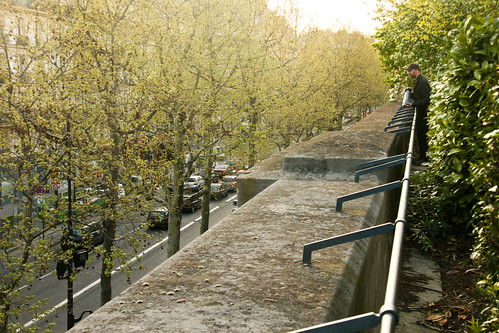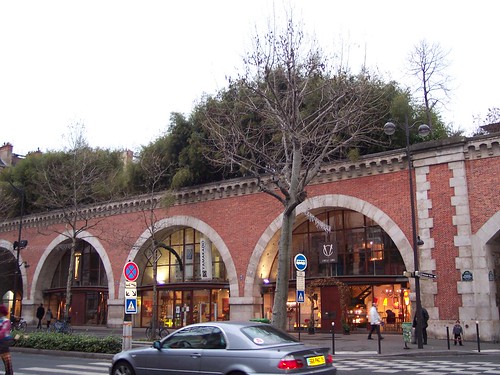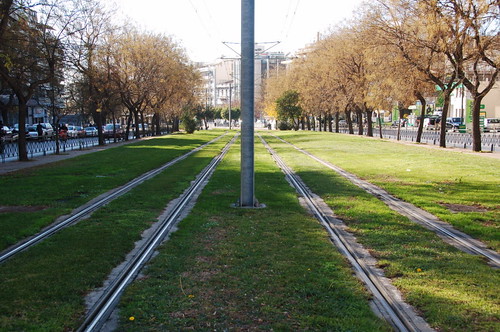As I said yesterday, elevated transport infrastructure don’t get no love.
In this, the second of two posts, we wrap up our list of the 10 most beautiful examples of elevated public transport infrastructure from around the world.
5. Station Square, Forest Hills Gardens – Queens, New York
As one of the first stops along New York City’s Long Island Rail Road (LIRR) commuter rail system, Forest Hills station is something to behold. Or not . . .
After all, the station itself is somewhat invisible, playing second-fiddle to the rest of the square. It doesn’t announce itself the way the rest of the plaza does, but instead acts as a curious Northern gateway into the square for daily commuters. Built in 1906 for the wealthy residents of Forest Hills Gardens of Queens, New York Station Square, understands the importance of vistas and viewsheds. It harkens back to old Europe, a place where enclosed public plazas are as common as parking lots are in Texas.
That a lowly transit station was so thoughtfully used as a staging ground for those vistas is impressive.
Station Square as viewed from the Grand Stairwell of Forest Hills Station. Image via Rego-Forest Preservation Council.
Ingenious urban design thinking is displayed throughout Station Square.
Track infrastructure was to be necessarily elevated above 71st Ave to allow for traffic flow between the north and south sides of the LIRR’s Main Line. And as we know, even back in the early 1900’s elevated track infrastructure was considered visual pollution and an eyesore.
But look what the architects and designers did to mitigate that problem:

Station Square from above. Note how the bridge motif is carried through the entire Square, making the elevated infrastructure an asset rather than a liability. Image via Air Space New York City.
Instead of ignoring the necessary bridge infrastructure, the square designers carried the bridges throughout the entire square. Instead of a square surrounded by separate buildings, all buildings were connected with similar bridge infrastructure that creates the impression of a single unified building and place.
The elevated track infrastructure therefore becomes an essential part of an architectural leitmotif that ties all of Station Square together.
Station Square is living proof that elevated infrastructure need not be a liability.
4. Im Viadukt – Zürich, Switzerland
We’ve already discussed Im Viadukt at length before, no point in reinventing the wheel.
Check out that post here.
3. Viaduc des Arts – Paris, France
In some ways the Viaduc des Arts of Paris is a bit of a cheat here. It used to be transport infrastructure, but now exists instead as an elevated park.
Originally inaugurated in 1859 by the private railroad company Paris Strasbourg, the Viaduc de la Bastille was an elevated railway line in the 12th Arrondissement of Paris. The railroad itself stopped running 100 years later, leaving a slew of useless elevated track infrastructure.
In 1979, the city began to contemplate what could be done with those tracks. Two options were presented: Tear it down or; repurpose the top of the viaduc and repopulate the vaults below with shops and studios. Interestingly, it was determined that tearing down the structure would have an adverse affect on the surrounding buildings and “ruin the landscape.”
The second option was therefore chosen and a plan to convert the rooftop to a linear green space was undertaken. The entire plan would take roughly 20 years to complete. Officially christened the Promenade Plantée, the transformation has left Paris with a beloved addition to the urban landscape.

The Promenade Plantée resting above the shops above of the Viaduc des Arts. Image by Fiona Cullinan.
You might argue that this shouldn’t be on this list. After all, it’s a park, not a piece of infrastructure. I’d argue otherwise.
The Viaduc des Arts represents what the past life of elevated infrastructure was and what it could be in the future. After all, there’s no reason that transit infrastructure cannot be placed within a green, park-like setting. We have no shortage of examples of trams, streetcars and light rail systems that are located partly or entirely within green spaces. The two are not mutually exclusive.
Why not have an elevated light rail line traversing the city through an elevated green space?
In other words, the Viaduc des Arts suggests a way forward. It suggests that you can, indeed, blend elevated transit infrastructure with the urban form in ways that are beautiful, complimentary, useful and cost-effective.
2. Ponte Vecchio – Florence, Italy
The Ponte Vecchio is one of Florence’s most enduring landmarks. Originally built in Roman times, the Ponte Vecchio bridges the narrowest point of the River Arno and has taken on numerous forms throughout the ages. But while the form has changed and been rebuilt several times, one concept has remained constant for at least the last 500 years: The bridge both doubles as a pedestrian causeway and as a market place.
One could reasonably argue that the Ponte Vecchio shouldn’t be on this list. After all, it isn’t – per se – elevated public transport infrastructure. It is, however, eleavated above another transport artery (the Arno River) and allows transport by foot (henceforth known as The Original PRT™).
So let’s just say it counts, okay?
The Ponte Vecchio is a beautiful – stunning, really – piece of transport infrastructure that serves its purpose while doing double-duty as both masker of infrastructure and extender of urban form. Shops and buildings line the bridge in a way that hides the internal activities for those viewing it from within and without. Yet the way in which it connects both sides of the river by way of an elevated marketplace prevents any sort of disruption of the urban fabric.

The interior market place of the Ponte Vecchio after all the shops have closed at night. Image by flickr user belpo.
It’s also an innovative technique for turning what would typically be a cost-centre (infrastructure) into a revenue generator by way of increased retail square footage. It’s an interesting concept: Rather than treat a piece of infrastructure as a boring and costly necessity, why not design it in such a way so that it can generate rent and tax base?
One question: Why haven’t other cities picked up on this?
1. Bridgemarket – New York City

Bridgemarket, a shopping and dining plaza located underneath Manhattan’s Queensboro Bridge. Image by flickr user Mark Chang.
Located underneath the Queensboro Bridge in Manhattan, Bridgemarket shares much in common with the other pieces of elevated infrastructure found on this list: Namely, it chooses to acknowledge that elevated infrastructure can be awkward and ugly and does something about it.
The difference between Bridgemarket and everything else on this list is that pedestrian use of the space underneath the bridge was designed in from the beginning. It wasn’t an afterthought. It was architect Henry Hornbostel’s attempt to better integrate the mammoth structure with street level urban life. The nave-like vaults that are underneath the Manhattan side of the bridge, meanwhile, were designed by Barcelona architect Rafael Guastavino who used a vernacular building technology called the Catalan vault.
A decade ago Hardy Holzman Pfeiffer Associates renovated the space and returned it to its food-borne roots, albeit with a slightly different clientele. Today, Bridgemarket isn’t the site of a humble food market but is instead a thriving hub of gentrifiers and yuppies. A new steel and glass pavilion is host to high-end food market The Food Emporium which also shares the space with Guastavino’s Restaurant – living testament to the fact that there’s no greater compliment for a dead architect than having an American-Italian restaurant named after you.
At the same time, one has to be impressed. How many other bridges have people shopping and dining under them?
The idea that the space underneath a piece of infrastructure is as important as the space above it underlies this work of art. Heading forward, cities should recognize transport infrastructure as an opportunity, not a threat. Bridgemarket is an excellent example of how to best do that.







11 Comments
@Viaduc Des Arts: “Why not have an elevated light rail line traversing the city through an elevated green space?”
Interesting. It really is.
I believe the space on those tracks is reduced to its minimum, so there isn’t much place for green. And if there would be: it would grow and be needed taken care of. On the other hand probably no one really wouldn’t mind if all out of the sudden an urban park strip would appear out of nowhere in front of your house and you would probably even be able to use it for cycling and so on. I think that is what could make some cities work.
@The Bridge in Florence:
“One question: Why haven’t other cities picked up on this?”
I’d say same answer as in most of those cases. Because there wasn’t the knowledge, thinking, investment, possibilities (by norms) to build it.
BUT, if someone has that idea and makes it crystal clear, that it’s a huge advantage, it will be considered as a serious option.
After all: most examples here aren’t really beauties and I’m missing classics as the loop for instance, but lots of them got surprisingly different ideas how to implement the “big stuff” towards it’s surounding and it is working! Gives me kind of a new perspective or at least my view is getting a bit clearer. Good posting CUP.
@ LX,
The reason the Loop wasn’t included was because I couldn’t find enough examples of it truly working with the urban fabric. Maybe “beautiful” was the wrong way to frame this list. Maybe it should’ve been about how well the systems work with and complement the urban fabric. Then again, try and work that into a title people will actually want to read ;).
If you put the Paris viaduct, you could also mention the New York High Line.
Also the Berlin Stadtbahn (humantransit mentioned it a while back).
As an aside, it seems that most bridges used to look like the Florence bridge in the middle ages. They all got cleaned up.
@ ant6n,
Didn’t know that about the Florence bridge styles. Do you have any images, references to this?
As for the Berlin Stadtbahn, we considered it, but it really doesn’t do much from a beauty/urban design perspective. It’s really kind of just a standard elevated train that disregards the urban fabric – at least all the parts of it I’ve seen/ridden. Do you know of any parts of it that really work with the urban fabric below?
Maybe a short listing of all possible other beauties would do (with a small picture like the ones in “you might also like” beyond the postings – with the title and the link for further information within). And the readers are free to add more to that list within the comments section.
As in case of the New York High Line I’d say it is pretty much exactly the same as the Paris viaduct – just different looks and another city.
@LX,
I think the reason we went with Paris rather than New York was because of how the Viaduc interacted with the street level.
@ant6n
the highline was elevated transit, but now it’s just a park. i guess you could argue it’s elevated pedestrian transport infrastructure, but really it’s just elevated green space with old rails running along it.
@SD, well you can start with the first sentence on Wikipedia “noted for still having shops built along it, as was once common”.
As was explained to me in a tour, bridges are very valuable places for retail, as there’s very high pedestrian traffic. In a city grid people may have dozens of choices for getting from point A to B, but once you get to a river they all funnel into one road.
There are other good examples of this. You can find retail in most any transit tunnel. There’s even gun shops (?!) in a pedestrian tunnel in Istanbul. Actually, the nearby Galata bridge is another good example of retail on bridges.
I walked across the Ponte Vecchio just last week! Interestingly, the Ponte Vecchio also carries the elevated and covered Vasari Corridor which is over 1km in length. It allowed the Medicis to traverse between the Palazzo Vecchio and the Palazzo Pitti without having to mingle with the plebs on the streets below. If the Ponte Vecchio is classed as elevated transport infrastructure, then the Vasari Corridor is in fact elevated transport infrastructure atop elevated transport infrastructure! The Ponte di Rialto in Venice is another example of the combination of pedestrian causeway and marketplace but altogether more graceful in my opinion! For me, the Wuppertal Schwebebahn would be the uncontested No.1. I think elevated infrastructure either needs to be so subtle and low impact that it blends seamlessly into the urban fabric or it needs to be so brutal and uncompromising that it creates an icon in its own right; those that lie in between these two extremes don’t seem to work. The Wuppertal Schwebebahn certainly applies the latter!
I like to use the term “living infrastructure.” I’m not sure it needs to be either totally suble or total brutal. I like infrastructure that blend into the urban fabric. Let’s call it Urban Fabristructure. Actually let’s not because Urban Fabristructure is just about the lamest thing I’ve ever come up with.